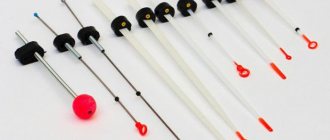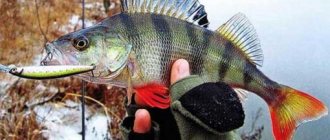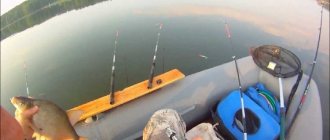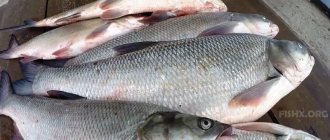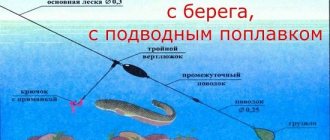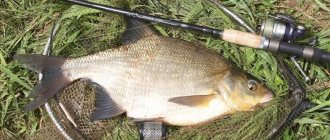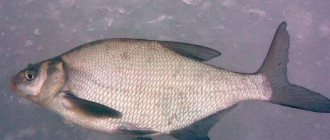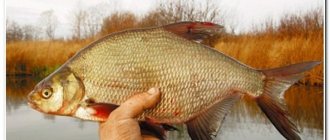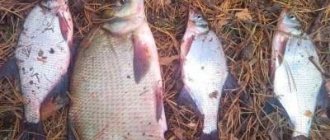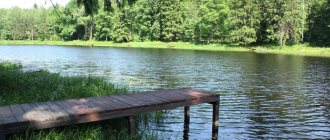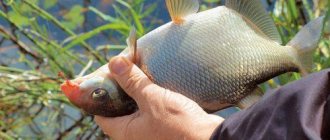How to catch large bream in the summer. Habitats used for catching bream tackle, bait and groundbait.
Even small breams are not as easy to catch as the ubiquitous perches and roaches. Large bream are even more difficult to catch. The bream itself is cautious, but the large bream is also experienced, and will not allow the angler to catch it so easily. A caught bream will always be a source of pride for a fisherman, and he can rightfully boast about it both to ordinary people and to his fellow fishermen. But catching bream in summer is not easy. You need to know the places where he likes to stay, the time when he will bite, and also select the appropriate gear and bait for this particular fish.
Bream habitats
Large bream, like most other species of large fish, prefer to stay in deep places in reservoirs and away from the shore. Only occasionally and at certain times of the day, large bream come closer to the shores to relatively shallow places to feed. He spends the rest of his time at depth. There he is quiet and calm, and there is less chance of being hooked by fishing enthusiasts.
Large bream prefer a flat bottom with sand or small pebbles. It does not disdain a muddy bottom, especially if the layer of silt is not thick and the lake itself has a predominantly muddy bottom. Pebbles, sand, perhaps a little silt or clay, and depth - this is the place where you are most likely to meet and catch a large bream.
Large bream in any body of water prefers deep holes where it lives and rests, sometimes going out to feed somewhere not far from its main site. Usually these places are a little smaller. If between two deep holes there is a hill with an uncluttered and flat bottom, then this will be a very promising and convenient place for catching large bream. You can almost certainly meet him here.
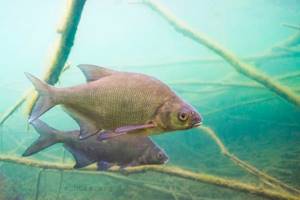
Large bream likes to stay near the river beds that flow into the reservoir, and on the river beds themselves. Such places are always deeper and form a kind of pit, bordering on the shallower depths of neighboring places. But at the same time, a prerequisite is a slow flow, or its almost complete absence. Large bream will not hold on in a fast current. Large bream do not like even the average speed of water flow, and they try to avoid such areas, preferring to find something calmer and quieter.
In addition to riverbeds, large bream also loves edges and places near them. It is important that there is not a lot of grass, snags, and other debris at the bottom, which do not allow the bream to calmly search for food. But not far from the same grass, bream can be found. There is quite a lot of food in the grass, which can tempt the bream and force it to stay nearby.
Bream is very fond of dressein mollusks, and where they are present on the bottom, especially in large quantities, you can count on the presence of bream, including large ones.
During the day, large bream stay away from the shore. He is alarmed by any noise, and he prefers to be away from it. It comes closer to the shores only late in the evening and at night, where it can be caught even from the shore with an ordinary long float rod.
Bream are most difficult to catch in large bodies of standing water. It seems that the very large size of the reservoir allows for the presence of large fish in it. But finding the place where this fish is located in such reservoirs is the most difficult thing. A large water area will require a lot of time to study and find suitable places where large bream are kept. If the reservoir is already familiar and the fisherman has fished in it before, then this can help with determining the place of future fishing. On a completely unfamiliar large lake, finding such a place becomes a problem.
An echo sounder can help you find a place. It will be possible to determine the bottom topography, depth and find the right place, suitable in its parameters for the habitat of large bream. It will even show the presence of fish at the bottom, or in the water column. Of course, for such fishing, in addition to an echo sounder, you will need a boat. You can try to focus on the external visible features of the terrain and shore. For example, a river flowing into a large lake would be a good place for a possible habitat for large bream. The riverbed will be deeper and will show a drop in depth which is suitable for a location where large bream can be found. Food is brought with the water, which also has a good effect on the ability to find fish here. All lakes are different and it can be difficult to determine where exactly large bream will live in a given body of water. But in one reservoir it can stay at depth, in another, on the contrary, it can stick to places closer to the grass thickets, where it periodically comes to eat. But it is large specimens that can most often be found in deep places. They are only suitable for places with shallower depths at night.
It will be easier to find large bream in rivers than in a large reservoir. Places with strong currents can be skipped immediately. Bream is not found here. But where the current becomes very weak, where the river forms a whirlpool, where the river bed changes its direction, forming reaches with quiet, calm water and a flat, slightly muddy bottom - in such places there are quite a lot of chances to meet and catch a large bream.
You can additionally observe the water surface. When a bream feeds, it sucks up soil from the bottom with its lips, and this causes air bubbles to rise to the surface of the water. Such bubbles can also be used to determine the presence of bream in a given location.
As for the time of day, it makes no sense to catch large bream during the day. During the day, bream sits out in the depths and is not particularly willing to feed. But night is perfect for fishing. It is at night that the best bite occurs and it is at night that fishermen go to catch large fish.
Towards evening, bream begins to become active, swim out of their deep shelters and come closer to the shore to places that are not so deep where they usually live. In such places there is more food and large bream spend all their time feeding here. The main time of activity occurs at night. In the morning, large bream go back into the depths away from the shore. Therefore, the main fishing takes place at night. It is at this time that the bite is best and you can catch good and really large specimens.
However, approaching closer to the shore does not mean that the bream will swim a few meters from land. This means that it approaches a distance of 20-30 m to the coastal zone with depths of several meters. Large specimens do not go into very shallow places, preferring to stick to deeper places. In the shallows you can only find very small breams, and even then infrequently.
At the beginning of summer, some time after spawning, bream begins a period of active feeding and is caught well. This can continue until mid-summer, after which the fish bite will become worse. But it doesn’t stop pecking completely. The bite just won’t be as good. But towards the end of summer, when the nights become darker and the air is a little cooler, large bream “come to life” again and begin to bite quite well. This continues until the beginning of autumn until it becomes completely cool. Then the bream also doesn’t stop biting completely, but the catch will be worse and the chances of catching large individuals will be less than at other times.
Promising Bream Fishing Points | Where to start your search?
Quite often, Bream feeds at the entrances to bays. At night, it goes to depths of 4-5 m, provided there is a good food supply.
But the most favorite places for large schools are: Slopes, alternating with a relief bottom.
Bream move exclusively along a route known only to them, sometimes bypassing promising areas where it is impossible to wait for it without serious bait.
In other places, in order to detain a flock, it is enough to lower the Feeder with Bait once every two hours into the Holes located within a radius of 5 m.

In the middle of Winter on the Uncharted Reservoir, it is quite difficult to spot Bream.
3 ways to improve your fish bite!

Over 15 years of active fishing, I have found many ways to improve the bite, and here are the most effective:
1. Bite activator . This pheromone additive attracts fish most strongly in cold and warm water. The Fish Hungry bite activator has proven itself to be excellent - Read more…
2. Tackle with increased sensitivity . You should first familiarize yourself with the features of using a particular type.
3. Pheromone baits . They attract the attention of fish, stimulate hunger and cause a schooling reflex, which allows you to collect a lot of fish in one place.
You can get the rest of the secrets of successful fishing for free by reading my other materials on the site.
3 ways to improve your fish bite!
Over 15 years of active fishing, I have found many ways to improve the bite, and here are the most effective:
1. Bite activator . This pheromone additive attracts fish most strongly in cold and warm water. The Fish Hungry bite activator has proven itself to be excellent - Read more…
2. Tackle with increased sensitivity . You should first familiarize yourself with the features of using a particular type.
3. Pheromone baits . They attract the attention of fish, stimulate hunger and cause a schooling reflex, which allows you to collect a lot of fish in one place.
You can get the rest of the secrets of successful fishing for free by reading my other materials on the site.
There are frequent cases when fish take at certain hours on the edges of the edges under unfavorable meteorological conditions. Often, having found a promising drop or edge, an angler is forced to bait 20 or more holes to achieve results.
It is strictly not recommended to feed 1 Plot and Holes located at the same Depths close to each other.
At the First Manifestations of Melting Ice Cover, Bream Move to the Shore in the Area:
Mouths of rivers and streams carrying melt water;
In Places Rich in Grass and Shrubs;
The Silted Shore is also suitable, with a gradual increase in depth.
During this period, bream is quite active, staying in quiet places, at shallow, sun-warmed depths. It’s worth starting your search for bream from these places.
The favorite places for large bream in the spring can also be shallows rich in shell rock. In the place where it is caught, there will be a Scavenger, there is a high chance of catching trophy specimens.
The spring bite usually lasts until the end of April, then abruptly stops, as Bream begins Spawning in May. And already from the beginning of June, after the Bream has spawned, the Mad Bite begins.
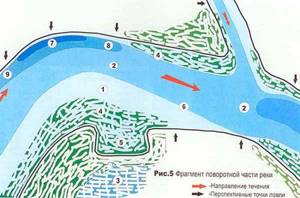
Bream fishing in summer
They catch bream, including large ones, mainly with bottom fishing rods, since they take bait mainly from the bottom. Bottom rods, feeders and long float rods are used to catch large bream. Float fishing rods are used less frequently due to the great depth at which fishing has to be done. You can fish with such fishing rods only if the fishing depth does not exceed two-thirds of the length of the fishing rod itself, or the fishing rod is equipped with a reel and the ability to release the fishing line to a greater length than the fishing rod itself. In all other cases, the best choice of tackle would be either a regular donka or a feeder tackle. Moreover, the feeder is used more often because of the greater convenience of fishing with this type of gear. Donka is simpler, but does not provide such sensitivity to the bite of cautious bream and such convenience when using the entire tackle as a whole. Therefore, the bulk of large bream is caught with a feeder. Other gear is used less frequently.

Time periods for summer bream fishing
The period of summer bream fishing, that is, in open water, can be divided into four main time periods.
In the spring, bream are better caught in warm shallows. The time period is characterized by the fact that bream (like any other fish) intensively fattens up before the upcoming spawn, feeding on high-calorie live food.
The second time period for bream fishing occurs at the beginning of the summer period. About a week after spawning, the fish begin to really eat. At the beginning of the summer feeding period, bream are better caught using live baits, although, often, they do not refuse baits of plant origin.
The third period refers to the hottest summer season of the year with the worst fishing conditions not only for bream, but also for other “white” fish. The time period is characterized by weak bream activity.
In addition, by the middle of the summer period, many fish of the carp family switch to feeding on young shoots of algae, which bream has no problems finding, so the fish quickly become saturated.
Summer bream fishing becomes less productive in the shallows, where the oxygen balance deteriorates significantly due to overheating of the water. Therefore, bream are forced to spend most of the daylight hours in cool, deep holes.
The best time period of the day for catching bream in the shallows in July - early August corresponds to evening twilight - night - early dawn. For night summer bream fishing, it is better to use moving baits. Although the fish will also smell odorous plant baits.
The fourth period of summer bream fishing begins around mid-August. At this time, the bream begins to prepare for the winter season. Closer to autumn, bream are better caught using high-calorie baits of animal origin.
Float rod
A float rod for catching large bream should be long enough, since you have to fish at fairly large depths, and the bream is taken mainly from the bottom. If the depth at the fishing spot is 5 meters, then the rod should be at least 6 meters long. And this is only if they are fishing from a boat and there is no need to make long casts. Otherwise, you simply won’t be able to catch properly. The bait should lie on the bottom, and the fishing rod should ensure its delivery to the right place in the reservoir. Therefore, for such fishing, they often use a fishing rod with rings and a reel, so that they can cast off part of the fishing line, make it longer than the rod itself, or be able to make long casts while maintaining a sufficiently large fishing depth.
There is nothing unusual about catching large bream with a float rod. Unless you need to carefully adjust the tackle, set the float so that the hook with bait either lies on the bottom or barely touches it. And of course, keep quiet, don’t fidget and try not to make any noise. Bream, especially large ones, are very cautious, and at the slightest noise they can become wary, stop being interested in the bait, or even completely move away from this place. When you get a bite, don’t hesitate to hook for too long. And you don’t have to hit with all your might. Bream have weak lips and you can simply tear them off. When bitten, the float begins to move to the side, and most often lies flat on the water when the bream lifts the bait from the bottom. You need to fish for large bream carefully and try to lift the fish to the very surface so that it “sips” air. After this, the resistance of the bream weakens and it will be easier to pull it ashore or lift it into the boat.
How to choose a fishing spot
Bream, like other representatives of cyprinids, is a schooling fish. The number of individuals in schools depends on the size of the fish; the larger the bream, the smaller the school. They choose their habitat far from the coastline, in places with a quiet current. For a parking site, choose large holes or a relief bottom at a depth of 3 meters. Bream migrate short distances to spawn or in search of food. You can catch fish both from a boat and from the shore, during their migration or by finding a feeding point.
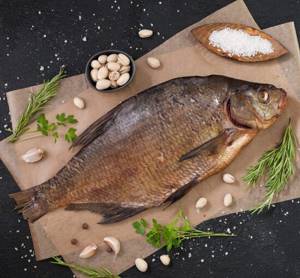
This place can be identified by the following characteristics:
- Coastlines with thickets of reeds;
- Clay, mud or sand banks;
- In reservoirs with large accumulations of algae;
- Small bubbles appear on the surface of the water;
- Or determine the presence of a school by characteristic bursts (at dawn in the morning or in the evening).
Having found such a place, feed the fish the day before fishing. If a bream stumbles upon your treat, it will most likely visit your place again. And then everything depends on you, your gear and skill.
Donka
When fishing for large bream, a bottom fishing rod is used much more often than a float fishing rod. And this is not surprising, because it is the bottom rod that can make a long cast, and it is the bottom rod that allows you to deliver the bait to the very bottom, which is what you need when catching bream. And if at night a large bream can swim close to the shores, then at other times of the day it will not be possible to reach it with an ordinary fishing rod. At least when fishing from the shore. When fishing with a donkey, there is no need to adjust the fishing depth. The bait lies directly on the bottom, which is what is needed for this type of fishing.
When fishing with a donkey, you need to carefully choose the place where the fishing will take place. It is necessary to study the bottom of the reservoir, depth differences, the presence of channels and edges. This is the only way to find a good place for fishing and cast into it. The bite of a bream on the bottom is determined by the ringing of a bell suspended from the tip of the rod after casting. Instead of a bell, they also use a large nod made of a twisted spring, fixed in the upper part of the fishing rod. The line is passed through it and after casting it is simply pulled up to a slight bend in the nod. If the tip is soft, then the bite can be seen by the vibrations of the tip. Some people observe a bite by the tension of a slightly slack fishing line. In any case, bites should be clearly visible. Large bream bite carefully and it is important not to miss the moment when he took the bait to make the hook.
Consideration of behavioral factors
When fishing for bream, you need to take into account its behavior. It rarely swims far from its habitat - it hunts and prepares to spawn there. What to catch bream with depends on the chosen fishing method. This is partly a predatory fish, but it can also bite on bread bait and boiled corn. Lives in mud, loves to hunt for small crustaceans and insects.
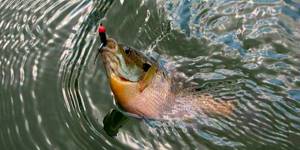
Depending on where bream theoretically lives, two types of catch can be distinguished:
- Day. At this time of day, he prefers depth, with the exception of the behavior of spawning individuals. During the day they can swim close to the shore. It is then relatively easy to catch bream if it is allowed.
- Night. In the dark, the fish prefers to stay near the shore. At night, when bream are biting, it is better to choose a place near the shore. You can use a worm as bait. To make the bite better, it is recommended to feed them. For bream fish, you can throw bread crumbs, for larger specimens - pieces of worm.
When fishing for bream, you should not hook too sharply. This is a shy fish, afraid of sudden movements. When spawning begins, small schools can be observed, which is already unusual for bream in June, when the spawning time ends. Then he prefers to stay apart from other individuals. Description of the correct patterns for tying a fishing hook to a fishing line - tips for fishermen
Feeder
A variety of donkey is a more modern feeder. On a feeder rod, a special soft tip with many guide rings acts as a very sensitive nod, which shows even a slight movement of the bait fish. Instead of the usual weight when fishing with a feeder, a small feeder is placed. With its help, not only bait is delivered to the bottom of the reservoir, but also additional groundbait, which helps to lure, collect, and hold large bream in a certain place. The weight of the feeder is selected according to the fishing location, depth and nature of the reservoir. On a river with a current, the feeders are taken heavier to avoid them being carried away by the current. On lakes and not very deep places, feeders are already placed with a smaller weight.
The feeder rod itself is selected for a specific fishing location and the size of the fish being caught. For large bream, the feeder is of medium and heavy classes, especially for fishing on large rivers. The casting distance also depends on the class and length of the rod, and large bream have to be caught mainly at long distances. Therefore, the appropriate rod is selected. So that you can cast far and catch large fish quite calmly.
The reel on the feeder is most often used inertialess medium or large size. The main fishing line for catching large bream should be 0.2 mm or thicker. You can quite successfully use braided fishing line instead of regular fishing line. But the leashes are placed much thinner than the main line. Their thickness depends on the caution of the fish and the quality of the bite. Sometimes it is enough to reduce the thickness of the leash and change its length so that bites begin to occur more often or stop altogether. This is already selected according to the location and depends on the fishing conditions and the reservoir where the fishing takes place.
Hooks for catching bream are used in small sizes and often with a long shank. The size of the hook depends more on the bait used. It will not be possible to put a bloodworm on a thick and large hook, and maggots and worms simply will not hold on to a small hook. Therefore, the fisherman should have spare hooks of different sizes with him, or a sufficient number of leashes with different hooks tied to them for different baits.
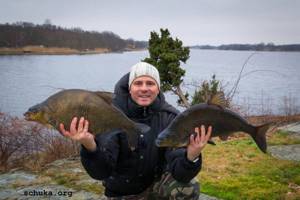
Preparing gear
This is a predatory fish, which is conventionally divided into two types: bream and bream. The latter has a mass of no more than one kg, its behavior may differ from that of an adult. It is recommended to prepare several types of gear. Already while fishing you can decide what is more effective for catching bream.
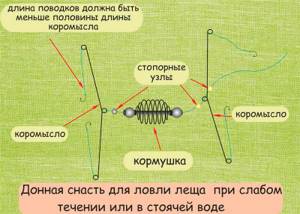
Traditional methods:
- Open feeder. You need to choose a rod up to 3.6 m long, a medium feeder or quiver, line thickness up to 0.15 mm. In spring, bream loves housefly larvae, a traditional bottom bait. First, the trap is thrown, and then, after 3-5 minutes, the rod is cast.
- Paternoster fixed. The recommended rod is a quiver with a soft and sensitive tip. The bait chosen is corn, earthworms or bread balls. This method is used to catch bream that are larger than average.
- Using the Method feeder. It is recommended to take a carp rod and fishing line with a breaking load of up to 4.5 kg. Corn kernels, red maggots or worms are used to attract potential prey. Relatively large bream bite on them, but catching bream is also possible.
- Using a semi-fixed sinker. Take a standard 12-foot rod and other gear. Additionally, you will need another one with a float to search for clean windows, since fishing will take place in places with a lot of algae. The fishing line is ordinary, you can use bait or boiled corn, pressed into a dense lump.
Feeder rig for beginners - catching bream in fast currents
Bream fishing is possible with a plug-in float. A fishing line with a breaking load of up to 1.4 kg is used; for better bite, annelids or maggots are used. The method is suitable for fishing with a regular-shaped fishing rod.
Groundbait and bait for bream
To catch bream, bait is necessary. You can also fish without it, but the effectiveness of such fishing will be much lower. Large bream need to be lured to the desired place, collected and kept nearby the entire time the fishing is taking place.
When fishing with a fishing rod at relatively short distances, bait can be periodically thrown into the desired place in the form of small cobbled together balls. It is necessary that such a ball sinks to the very bottom and does not have time to fall apart in the water column. To do this, the mixture is made thicker than usual, and to make the entire ball heavier, you can additionally put a small stone inside it. The deeper the fishing spot, the heavier the stone needs to be taken.
When fishing with a donkey, such balls will have to be thrown over longer distances. It’s just not always possible to throw the ball to the right place with your hand. Therefore, in such cases, special slingshots are often used. The balls themselves are made small, placed in a slingshot and shot at the desired location. You just need to practice a little with a slingshot first before fishing, otherwise during the fishing itself the bait will fly in the wrong place.
It's easier with a feeder. Here, with each cast, the bait is placed in a special feeder, combined with the main load. At the very beginning of fishing, 5-10 casts are made only with a feeder with bait in order to feed the fishing spot. And then the bait is delivered to the right place in small portions with each subsequent cast of the tackle.
The bait itself can be taken ready-made, or made independently from various cereals with additives that give it certain aromas that large bream like and will attract. For example, ground sunflower seeds, cake, or hemp will be very good additives for such bait. There are also commercial flavors with different flavors. You need to add them in very small quantities so as not to overdo it and scare away the fish instead of attracting them. In addition, it is very advisable to add to the feeding those components that are going to be used for fishing. If you fish with a worm, you can add chopped worms. If it is for bloodworms, then crushed bloodworms will be a very good addition to the feeding mixture.
When fishing on a current, the mixture needs to be made thicker so that it is not washed out so quickly by water and is not carried far from the casting point. In stagnant waters, on the contrary, the mixture is made so that it is quickly washed out of the feeder lying motionless at the bottom.
The bait for catching large bream is worms, maggots, bloodworms, or a combination of 2-3 different baits on the hook - the so-called “sandwich”. Vegetable baits are also used when catching large bream. Peas and corn are used, very thick pearl barley porridge and mastyrka - a special bait made from several components, similar to thick dough.
Summer bream fishing areas on the river
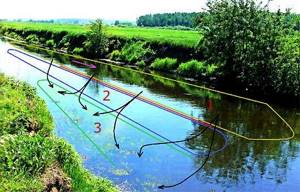
The picture shows a drawing of the bed of a small river with places for summer fishing for active bream and areas where fish live on vacation or in unfavorable weather.
Sector No. 1 corresponds to the channel pit. In summer, bream can live in this section of the river for a long time in the most comfortable conditions. During the day in the July heat, at a cool depth, the oxygen balance is much better than in shallow waters, and the current is less.
In such sections of rivers, fish digest food after a heavy morning feeding, and catching a well-fed bream with an abundance of summer food is unlikely to contribute to a decent fishing result.
Area No. 3 corresponds to the summer feeding area, and, therefore, the most effective bream fishing. At certain times of the day, in favorable weather, fish from the channel pit come out to the coastal shallows. Such places on rivers are the richest in food. The best bite of bream in summer is observed at the beginning of its feeding period in shallows.
These are exactly those sections of the river where fishermen can get a good catch of bream without bait. Although, perhaps, with some material costs in the form of dangling gear.
Section No. 2 is suitable for catching bream in summer with plug rods from its shore. It is better to cast bottom casting gear from the opposite bank of the river.
At the same place you can put a boat on guy wires. Then it can be successful to catch passing bream with side rods, or you can cast a tackle with a float to catch fish along the edge of the weeds.
With the right bait, catching large bream can be promising at the entrance of a river hole (corresponds to the red line in the picture). A seasoned, cautious bream, having noticed a fisherman on the shore, does not go to the coastal shallows in the summer.
Black lines indicate the expected directions of bream trails with bottom inhomogeneities located there in the form of hills located across the current or, on the contrary, hollows.
These are the most convenient directions for bream to cross the river flow from long-term habitats to feeding areas and back. If the timing is right, the trails will be the best areas for summer bream fishing.
Large bream bite carefully
Sometimes it chews the bait for a long time before it eats it. There is no need to rush into cutting. Premature hooking can simply scare a cautious bream. After hooking, you need to start fishing. The fact that the fish is large will be felt by its resistance. There is also no need to rush into fishing. Especially when using thin leashes. You can simply break the leash and miss the fish. You need to slowly pull the fish towards you. A flexible rod will absorb strong jerks. If you have a spinning reel, a correctly configured clutch will additionally help. A large bream needs to be raised to the surface and made to take a breath of air. Then his resistance weakens, and fishing will be much easier. It is best to catch large bream with a net, especially if there is a steep bank in the fishing area, or when fishing from a boat.
Catching large bream in the summer is actually not very difficult. The main thing is to choose the right fishing location, weather, carefully select gear, choose good bait and the right bait. And then catching bream will not become a difficult task for the fisherman.
Secrets of successful fishing
The secret to successful fishing is simple. The first stage is to find a “cool” place, the second is to choose the right time to hunt bream. The activity of fish depends on the time of year and time of day. In winter it is practically inactive, but you can catch it. In summer, the fish are capricious; a cloudy, rainy and cool day without strong wind is good. The best period for fishing is in spring and autumn.
The most suitable months are April and September. Do not forget that bream is extremely shy and wary. The fishing situation should be extremely quiet, without sudden or unnecessary actions, so as not to cause noise and splashes on the water. Observing all measures of caution and accuracy, even for an experienced fisherman, the bite begins after an hour.
Tackle
When choosing gear you need to be careful. An incorrectly configured fishing rod can ruin your entire fishing trip. Even if you chose a promising place and fed it.
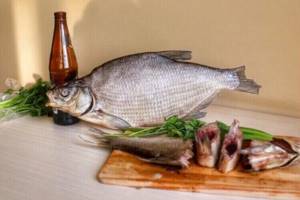
There are two opinions on the choice of gear. Some people believe that to fish for a large specimen you need to choose a thick line and a large hook. The latter prefer to use the thinnest line and small hooks. The choice of equipment is yours. Stop at the golden mean. Choose gear that will be minimally visible to bream, but at the same time durable.
Fishing rods and donks
Float fishing is convenient on the shore where the current is minimal. A fishing rod feeder is usually not used. Baiting is done by throwing treat balls into the water. The float used is a regular, oval one with a long antenna. Sinkers are installed on the fishing line, several pieces in ascending order. It is better to fish with a float rod in spring or autumn, when it is not very hot and it does not sink to the bottom.
Catching bream with a bottom fishing rod is more promising than with a fishing rod, and besides, the process can be carried out in any season. Only more experience and training will be required for this kind of fishing. Fishing is done both from the shore and from boats, but the latter option is much more successful. Baiting is done either by throwing prepared balls into the water, or by attaching various feeders.
Feeder
looks like a donkey. Fishing conditions remain the same (feeding, bait and choice of location). When choosing a feeder, you should take into account the characteristics of the reservoir and the fishing distance. The rod must be durable; this is important for tempo fishing. The coil chosen is a power, inertia-free one. Feeders use a cage type. Fishing itself is dynamic, so more than two gears are used simultaneously.
Spinning
Spinning fishing can bring good results, as fishermen have noticed that large specimens are often caught on artificial tackle. When fishing from the shore, they use powerful rods with inert reels and a fairly heavy sinker. A spoon is attached near the hook, which imitates a small fish. Depending on the region, spinning fishing takes place in the fall or early summer.

Networks
Not the most popular type of bream fishing, but it does occur. For this method of fishing you must have good skill. The net must be placed correctly so that the fish get into it and do not pass by. It is worth choosing a net with a large mesh, the line is not coarse and hardly noticeable. Only net fishing is not always allowed, so mesh bags are often used, where the size of the cage can be smaller. Bait is carried out as in float fishing.
Lures and baits (artificial and natural)
Both plant and animal baits are suitable for bream. But in order to have a stable catch of bait, you need to skillfully combine it. Experienced fishermen have noticed that in warm weather, bream prefers various baits, and in cold weather it is better to take bait. There are three types of bait:
- Animal baits (maggots, bloodworms, worms, shellfish meat).
- Vegetable baits (boiled peas, canned corn, steamed barley grains, bread crumb)
- Artificial bait (imitates animal bait, comes in various colors and sizes).
